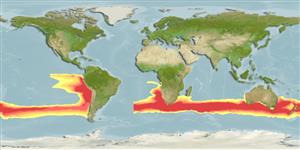Teleostei (teleosts) >
Scombriformes (Mackerels) >
Centrolophidae (Medusafishes)
Etymology: Schedophilus: Name from Greek words 'phylos' (Φίλος), t) meaning 'one who likes' and "s 'shedia' (Σχεδία) which means raft; literally means 'the one who likes rafts'. This probably refers to the lifestyle ot the juveniles of this genus (Michail Ragousis, mar10091@marine.aegean.gr, pers. Comm. 01/16) which are epipelagic and associate with floating jellyfish.
Eponymy: Frederick Wollaston Hutton (1836–1905) was an English geologist and zoologist who settled in New Zealand. [...] (Ref. 128868), visit book page.
More on author: Waite.
Environment: milieu / climate zone / depth range / distribution range
Ecology
Marine; bathypelagic; oceanodromous (Ref. 51243); depth range 0 - 1000 m (Ref. 9563), usually 270 - 500 m (Ref. 36731). Deep-water
Southwest Pacific: Australia (including Victoria and Tasmania) and New Zealand. Southeast Pacific: Peru and Chile (Ref. 9068). Western Indian Ocean: South Africa. Atlantic Ocean: northernmost record, 18°S.
Size / Weight / Age
Maturity: Lm ? range ? - ? cm
Max length : 90.0 cm TL male/unsexed; (Ref. 4410)
Plain blackish grey to brown in color (Ref. 4410).
Occurs at the edge of the continental shelf and near oceanic islands (Ref. 6942). Adults are demersal on the continental slope in 800 to 1,000 m; subadults and juveniles found in surface waters (Ref. 9563).
Life cycle and mating behavior
Maturity | Reproduction | Spawning | Eggs | Fecundity | Larvae
Haedrich, R.L., 1990. Centrolophidae. p. 1011-1013. In J.C. Quero, J.C. Hureau, C. Karrer, A. Post and L. Saldanha (eds.) Check-list of the fishes of the eastern tropical Atlantic (CLOFETA). JNICT, Lisbon; SEI, Paris; and UNESCO, Paris. Vol. 2. (Ref. 6942)
IUCN Red List Status (Ref. 130435: Version 2024-1)
Threat to humans
Harmless
Human uses
Tools
Special reports
Download XML
Internet sources
Estimates based on models
Preferred temperature (Ref.
123201): 7.2 - 12.4, mean 9.5 °C (based on 130 cells).
Phylogenetic diversity index (Ref.
82804): PD
50 = 0.5039 [Uniqueness, from 0.5 = low to 2.0 = high].
Bayesian length-weight: a=0.00389 (0.00180 - 0.00842), b=3.12 (2.94 - 3.30), in cm total length, based on all LWR estimates for this body shape (Ref.
93245).
Trophic level (Ref.
69278): 4.1 ±0.6 se; based on size and trophs of closest relatives
Resilience (Ref.
120179): Low, minimum population doubling time 4.5 - 14 years (Preliminary K or Fecundity.).
Fishing Vulnerability (Ref.
59153): High vulnerability (56 of 100).
